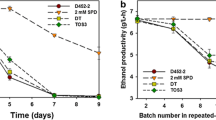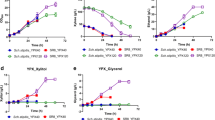Abstract
Saccharomyces cerevisiae is a promising candidate for production of organic acids as it is more tolerant to these acids than the prokaryotes. However, the large-scale production of organic acids from lignocellulosic biomass is limited by their accumulation in the growth medium and inability of xylose fermentation by S. cerevisiae. Here we showed that high intracellular spermidine (SPD) contents confers enhanced tolerance to lactic, succinic, and malic acids in S. cerevisiae. Specifically, in the presence of 20 g/L malic acid, the maximum specific growth rate and dry cell weight of a S. cerevisiae with two fold higher SPD content were 40% and 36% higher than those of the control strain. When a xylose assimilation pathway was introduced into an engineered strain with high SPD content, the resulting S. cerevisiae strain exhibited 23∼47% higher xylose consumption rate and 6∼16% higher ethanol productivity than those of the control strain during the four times of repeated-batch fermentations using a mixture of glucose and xylose as carbon sources. These results suggest that the strain developed in this study would serve as a platform strain for production of organic acids.
Similar content being viewed by others
References
Es, I., A. M. Khaneghah, F. J. Barba, J. A. Saraiva, A. S. Sant’Ana, and S. M. B. Hashemi (2018) Recent advancements in lactic acid production - a review. Food Res. Int. 107: 763–770.
Akhtar, J., A. Idris, and R. Abd Aziz (2014) Recent advances in production of succinic acid from lignocellulosic biomass. Appl. Microbiol. Biotechnol. 98: 987–1000.
Mienda, B. S. and F. M. Salleh (2017) Bio-succinic acid production: Escherichia coli strains design from genome-scale perspectives. Aims Bioeng. 4: 418–430.
Heo, W., J. H. Kim, S. Kim, K. H. Kim, H. J. Kim, and J. H. Seo (2019) Enhanced production of 3-hydroxypropionic acid from glucose and xylose by alleviation of metabolic congestion due to glycerol flux in engineered Escherichia coli. Bioresour. Technol. 285: 121320.
Lee, Y., O. Nasution, Y. M. Lee, E. Kim, W. Choi, and W. Kim (2017) Overexpression of PMA1 enhances tolerance to various types of stress and constitutively activates the SAPK pathways in Saccharomyces cerevisiae. Appl. Microbiol. Biotechnol. 101: 229–239.
Hasunuma, T., T. Sanda, R. Yamada, K. Yoshimura, J. Ishii, and A. Kondo (2011) Metabolic pathway engineering based on metabolomics confers acetic and formic acid tolerance to a recombinant xylose-fermenting strain of Saccharomyces cerevisiae. Microb. Cell Fact. 10: 2.
Mira, N. P., M. C. Teixeira, and I. Sa-Correia (2010) Adaptive response and tolerance to weak acids in Saccharomyces cerevisiae: a genome-wide view. OMICS. 14: 525–540.
Baek, S. H., E. Y. Kwon, S. Y. Kim, and J. S. Hahn (2016) GSF2 deletion increases lactic acid production by alleviating glucose repression in Saccharomyces cerevisiae. Sci. Rep. 6: 34812.
Eraso, P. and C. Gancedo (1987) Activation of yeast plasma membrane ATPase by acid pH during growth. FEBS Lett. 224: 187–192.
Pampulha, M. E. and M. C. Loureiro-Dias (1990) Activity of glycolytic enzymes of Saccharomyces cerevisiae in the presence of acetic acid. Appl. Microbiol. Biotechnol. 34: 375–380.
Branduardi, P., M. Sauer, L. De Gioia, G. Zampella, M. Valli, D. Mattanovich, and D. Porro (2006) Lactate production yield from engineered yeasts is dependent from the host background, the lactate dehydrogenase source and the lactate export. Microb. Cell Fact. 5: 4.
Kim, S. K., Y. S. Jin, I. G. Choi, Y. C. Park, and J. H. Seo (2015) Enhanced tolerance of Saccharomyces cerevisiae to multiple lignocellulose-derived inhibitors through modulation of spermidine contents. Metab. Eng. 29: 46–55.
Balasundaram, D., C. W. Tabor, and H. Tabor (1993) Oxygen toxicity in a polyamine-depleted spe2Δ mutant of Saccharomyces cerevisiae. Proc. Natl. Acad. Sci. USA. 90: 4693–4697.
Eisenberg, T., H. Knauer, A. Schauer, S. Buttner, C. Ruckenstuhl, D. Carmona-Gutierrez, J. Ring, S. Schroeder, C. Magnes, L. Antonacci, H. Fussi, L. Deszcz, R. Hartl, E. Schraml, A. Criollo, E. Megalou, D. Weiskopf, P. Laun, G. Heeren, M. Breitenbach, B. Grubeck-Loebenstein, E. Herker, B. Fahrenkrog, K. U. Frohlich, F. Sinner, N. Tavernarakis, N. Minois, G. Kroemer, and F. Madeo (2009) Induction of autophagy by spermidine promotes longevity. Nat. Cell Biol. 11: 1305–1314.
Stanley, D., A. Bandara, S. Fraser, P. J. Chambers, and G. A. Stanley (2010) The ethanol stress response and ethanol tolerance of Saccharomyces cerevisiae. J. Appl. Microbiol. 109: 13–24.
Kwak, S., J. H. Jo, E. J. Yun, Y. S. Jin, and J. H. Seo (2019) Production of biofuels and chemicals from xylose using native and engineered yeast strains. Biotechnol. Adv. 37: 271–283.
Turner, T. L., G. C. Zhang, S. R. Kim, V. Subramaniam, D. Steffen, C. D. Skory, J. Y. Jang, B. J. Yu, and Y. S. Jin (2015) Lactic acid production from xylose by engineered Saccharomyces cerevisiae without PDC or ADH deletion. Appl. Microbiol. Biotechnol. 99: 8023–8033.
Kim, S. K., J. H. Jo, Y. C. Park, Y. S. Jin, and J. H. Seo (2017) Metabolic engineering of Saccharomyces cerevisiae for production of spermidine under optimal culture conditions. Enzyme Microb. Technol. 101: 30–35.
Hosaka, K., J. Nikawa, T. Kodaki, and S. Yamashita (1992) A dominant mutation that alters the regulation of Ino1 expression in Saccharomyces cerevisiae. J. Biochem. 111: 352–358.
Kim, S. K., J. H. Jo, Y. S. Jin, and J. H. Seo (2017) Enhanced ethanol fermentation by engineered Saccharomyces cerevisiae strains with high spermidine contents. Bioprocess Biosyst. Eng. 40: 683–691.
Wickerham, L. J. (1946) A critical evaluation of the nitrogen assimilation tests commonly used in the classification of yeasts. J. Bacteriol. 52: 293–301.
Jo, J. H., Y. C. Park, Y. S. Jin, and J. H. Seo (2017) Construction of efficient xylose-fermenting Saccharomyces cerevisiae through a synthetic isozyme system of xylose reductase from Scheffersomyces stipitis. Bioresour. Technol. 241: 88–94.
Abbott, D. A., R. M. Zelle, J. T. Pronk, and A. J. A. van Maris (2009) Metabolic engineering of Saccharomyces cerevisiae for production of carboxylic acids: current status and challenges. FEMS Yeast Res. 9: 1123–1136.
Uemura, T., K. Kashiwagi, and K. Igarashi (2007) Polyamine uptake by DUR3 and SAM3 in Saccharomyces cerevisiae. J. Biol. Chem. 282: 7733–7741.
Palanimurugan, R., H. Scheel, K. Hofmann, and R. J. Dohmen (2004) Polyamines regulate their synthesis by inducing expression and blocking degradation of ODC antizyme. EMBO J. 23: 4857–4867.
Zelle, R. M., E. de Hulster, W. A. van Winden, P. de Waard, C. Dijkema, A. A. Winkler, J. M. A. Geertman, J. P. van Dijken, J. T. Pronk, and A. J. A. van Maris (2008) Malic acid production by Saccharomyces cerevisiae: Engineering of pyruvate carboxylation, oxaloacetate reduction, and malate export. Appl. Microbiol. Biotechnol. 74: 2766–2777.
McKinlay, J. B., C. Vieille, and J. G. Zeikus (2007) Prospects for a bio-based succinate industry. Appl. Microbiol. Biotechnol. 76: 727–740.
Werpy, T. and G. Petersen (2004) Top value added chemicals from biomass: Volume I: results of screening for potential candidates from sugars and synthesis gas. Technical report, U.S. Department of Energy, Oak Ridge, TN, USA.
Abbott, D. A., T. A. Knijnenburg, L. M. I. de Poorter, M. J. T. Reinders, J. T. Pronk, and A. J. A. van Maris (2007) Generic and specific transcriptional responses to different weak organic acids in anaerobic chemostat cultures of Saccharomyces cerevisiae. FEMS Yeast Res. 7: 819–833.
Mira, N. P., A. B. Lourenco, A. R. Fernandes, J. D. Becker, and I. Sa-Correia (2009) The RIM101 pathway has a role in Saccharomyces cerevisiae adaptive response and resistance to propionic acid and other weak acids. FEMS Yeast Res. 9: 202–216.
Kim, S. R., K. S. Lee, J. H. Choi, S. J. Ha, D. H. Kweon, J. H. Seo, and Y. S. Jin (2010) Repeated-batch fermentations of xylose and glucose-xylose mixtures using a respiration-deficient Saccharomyces cerevisiae engineered for xylose metabolism. J. Biotechnol. 150: 404–407.
Zhang, J. and R. Greasham (1999) Chemically defined media for commercial fermentations. Appl. Microbiol. Biotechnol. 51: 407–421.
Kim, S. R., J. M. Skerker, W. Kang, A. Lesmana, N. Wei, A. P. Arkin, and Y. S. Jin (2013) Rational and evolutionary engineering approaches uncover a small set of genetic changes efficient for rapid xylose fermentation in Saccharomyces cerevisiae. PLos One. 8: e57048.
Kim, S. R., Y. C. Park, Y. S. Jin, and J. H. Seo (2013) Strain engineering of Saccharomyces cerevisiae for enhanced xylose metabolism. Biotechnol. Adv. 31: 851–861.
Ha, S. J., J. M. Galazka, S. R. Kim, J. H. Choi, X. Yang, J. H. Seo, N. L. Glass, J. H. D. Cate, and Y. S. Jin (2011) Engineered Saccharomyces cerevisiae capable of simultaneous cellobiose and xylose fermentation. Proc. Natl. Acad. Sci. USA. 108: 504–509.
Gopinarayanan, V. E. and N. U. Nair (2018) A semi-synthetic regulon enables rapid growth of yeast on xylose. Nat. Commun. 9: 1233.
Acknowledgements
This work was financially supported by the National Research Foundation of Korea (NRF) Grant (2019R1C 1C1003521) funded by the Korean Ministry of Science, ICT and Future Planning.
The authors declare no conflict of interest.
Neither ethical approval nor informed consent was required for this study.
Author information
Authors and Affiliations
Corresponding authors
Additional information
Publisher’s Note
Springer Nature remains neutral with regard to jurisdictional claims in published maps and institutional affiliations.
Electronic Supplementary Material (ESM)
Rights and permissions
About this article
Cite this article
Kim, SK., Auh, JH. Evaluating the Engineered Saccharomyces cerevisiae With High Spermidine Contents for Increased Tolerance to Lactic, Succinic, and Malic Acids and Increased Xylose Fermentation. Biotechnol Bioproc E 26, 47–54 (2021). https://doi.org/10.1007/s12257-020-0020-y
Received:
Revised:
Accepted:
Published:
Issue Date:
DOI: https://doi.org/10.1007/s12257-020-0020-y




